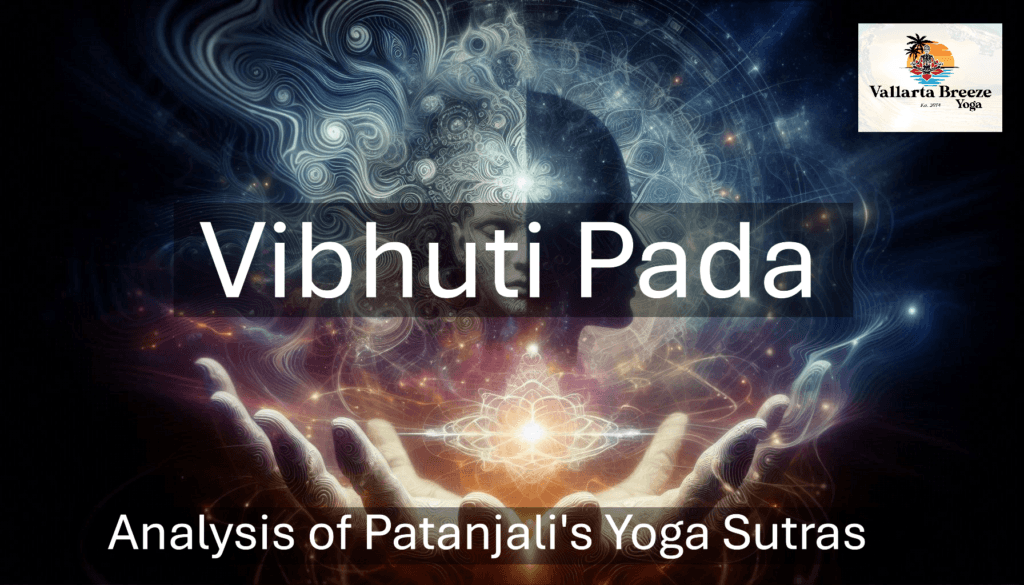Analysis of the Vibhuti Pada
The third book of Patanjali’s Yoga Sutras, known as Vibhuti Pada, is a profound exploration of advanced yogic practices. It serves as a roadmap to the subtle dimensions of consciousness through disciplined mental inquiry and meditation. Rather than merely offering techniques, this text delves deep into the nature and potential of the inner self, guiding practitioners toward the ultimate goal of yoga—liberation (kaivalya).
The Structure of Advanced Practice
Concentration, Meditation, and Samadhi
- Dharana, Dhyana, and Samadhi:
Vibhuti Pada begins by elucidating the three successive practices:- Dharana (Concentration): Focusing the mind on a single point or object, establishing a foundation for deeper inquiry.
- Dhyana (Meditation): A sustained, uninterrupted flow of attention that deepens inner awareness.
- Samadhi (Absorption): The final stage where the distinction between the observer and the observed dissolves into one seamless state of pure awareness.
Siddhis (Extraordinary or Supernatural Powers)
The Emergence and Role of Siddhis
- Development of Siddhis:
As the mind becomes refined through samyama, various extraordinary abilities, or siddhis, may spontaneously arise. These can include:- Recall of past lives
- Telepathy and extrasensory perception
- Control over natural elements
- Clairvoyance and heightened intuition
- Siddhis: By-products, Not the End Goal:
Patanjali makes it clear that although these powers are fascinating, they are merely side effects of deep meditation. The true purpose of practice is not to accumulate supernatural powers but to use them—if they arise—merely as tools or stepping stones on the path to liberation.
Detachment from Siddhis
- The Pitfall of Attachment:
Teachers and students alike are cautioned to develop equanimity. Becoming overly focused on or attached to siddhis can become a distraction, regressing the aspirant into a state of egoistic identification with manifested abilities. This attachment may eventually hinder the progress toward kaivalya, as it ties the mind to the transient and phenomenal rather than the eternal. - Practical Guidance:
Both practitioners and instructors are encouraged to cultivate a balanced practice that views siddhis as transient phenomena. The emphasis is on using them to deepen insight and remain steadfast on the path to self-realization.
The Nature of the Mind
Interplay of Gunas and the Process of Transformation
- Understanding Gunas:
Vibhuti Pada also provides a sophisticated analysis of the three fundamental qualities (gunas)—sattva (purity), rajas (activity), and tamas (inertia)—which inform the behavior of the mind. Their interplay underlies the manifold expressions of human experience. - Samskaras and Parinama (Transformation):
The sutras detail how impressions (samskaras) and subtle modifications of the mind lead to continuous transformations (parinama). This framework helps practitioners to see the processes that condition their thoughts, emotions, and perceptions. For a teacher, this offers valuable insights into guiding students on how to dismantle these habitual patterns, ultimately revealing a state of pure self-awareness.
Liberation
The Goal of Transcendence: Kaivalya
- Dissolution of Mental Modifications:
Vibhuti Pada concludes with insights into the dissolution of the mind’s fluctuations and conditioned activities. When the deep-rooted impressions finally dissolve, the mind becomes unbound—a state known as kaivalya (liberation). This is not simply an intellectual understanding but a transformative realization and direct experience of one’s true nature. - Implications for Practitioners:
For the dedicated student, this state heralds a profound inner freedom—a liberation from the cycles of birth and death, suffering and rebirth. For the teacher, it is a reminder that guiding students involves helping them shift their focus from external achievements (such as siddhis) to actual self-realization and inner freedom.
Practical Applications for Students and Teachers
- For Students:
Vibhuti Pada provides a clear, experiential framework. Integrating these advanced practices into daily meditation helps deepen insight into the nature of the mind. Students are encouraged to remain patient, disciplined, and detached in order to steadily progress along the path. - For Teachers:
As a reference, Vibhuti Pada offers invaluable guidance on how to interpret advanced experiences. Teachers may use its insights to design classes, workshops, and individual guidance sessions that emphasize self-inquiry over mere power attainment. It serves as a reminder that the goal of yoga is inner liberation, not the external demonstration of extraordinary abilities.
List of Sutras
| Sutra Number | Sanskrit (Roman Transliteration) | English Translation |
|---|---|---|
| 3.1 | Deshabandhashchittasya dharana | Concentration is the binding of the mind to one place. |
| 3.2 | Tatra pratyayaikatannata dhyanam | Meditation is the continuous flow of cognition toward that object. |
| 3.3 | Tadevarthamatranirbhasam svarupashunyam iva samadhih | Absorption is the same meditation when there is only the object, as if devoid of its own form. |
| 3.4 | Trayamekatra samyamah | The three together—concentration, meditation, and absorption—constitute samyama. |
| 3.5 | Tajjayat prajnalokah | By mastering samyama, the light of higher knowledge dawns. |
| 3.6 | Tasya bhumishu vinayah | Its application is in stages. |
| 3.7 | Trayamantarangam purvebhyah | These three are more internal than the previous practices. |
| 3.8 | Tadapi bahirangam nirbijasya | Even these are external practices compared to seedless absorption (nirbija samadhi). |
| 3.9 | Vyutthana-nirodha-samskarayoh abhibhava-pradurbhavau nirodha-kshana-chittanvayo nirodhaparinamah | The transformation toward restraint arises when the mind’s tendency toward distraction and restraint balances, with the moment of restraint becoming predominant. |
| 3.10 | Tasya prasanta-vahita samskarat | The flow of tranquility stems from this transformation. |
| 3.11 | Sarvarthataikagratayo kshayodayau chittasya samadhiparinamah | The transformation of absorption occurs as the distractions fade and one-pointedness arises. |
| 3.12 | Tatah punah shantoditau tulya-pratyayau chittasya-ekagrata-parinamah | The transformation toward one-pointedness arises when the mind settles on equivalent perceptions, both tranquil and emergent. |
| 3.13 | Etena bhutendriyeshu dharma-lakshana-avastha-parinama vyakhyatah | Through this, the transformations of the elements and senses—characteristic, temporal, and positional—are explained. |
| 3.14 | Shanta-udita-avyapadeshya-dharma-anupati dharmi | The substratum is the bearer of latent, manifest, and unmanifest qualities. |
| 3.15 | Kramanyatvam parinamanyatve hetuh | The cause of transformations is the variation in the sequence of changes. |
| 3.16 | Parinamatraya-samyamad atitanagata-jnanam | By samyama on the threefold transformation, knowledge of past and future arises. |
| 3.17 | Shabda-artha-pratyaya-samyamat sarvabha-rutajnana | By samyama on the sound, meaning, and perception of words, knowledge of all languages arises. |
| 3.18 | Samskarasakshatkaranat purvajati-jnanam | By perceiving latent impressions, knowledge of previous lives arises. |
| 3.19 | Pratyayasya paracitta-jnanam | By perceiving mental impressions, knowledge of others’ minds arises. |
| 3.20 | Na cha tat salambanam tasya-avishayinam | But this does not reveal the basis of the thought, as that is not the object of focus. |
| 3.21 | Kayarupa-samyamat tadgrahya-shakti-stambhe chakshuh-prakashasamprayoge-antardhanam | By samyama on the form of the body and its suspension from the light of perception, invisibility arises. |
| 3.22 | Etena shabda-adidayah-uktah | In this way, other objects of focus like sound are also explained. |
| 3.23 | Sopakrama nirupakrama-cha karma tat-samyamat aparantajnana-aristebhyah va | By samyama on actions, whether fast or slow, knowledge of the time of death arises. |
| 3.24 | Maitri-adishu balani | By samyama on friendliness and other virtues, strength arises. |
| 3.25 | Baladini-indriyani | By samyama on the powers of the senses, their strength arises. |
| 3.26 | Pratibhad-va sarvam | Or, through intuition, all knowledge arises. |
| 3.27 | Bhuvanajnana suryam samyamat | By samyama on the sun, knowledge of the world arises. |
| 3.28 | Chandre taravyuhajnanam | By samyama on the moon, knowledge of the starry arrangement arises. |
| 3.29 | Dhruve tadgatijnanam | By samyama on the pole star, knowledge of motion arises. |
| 3.30 | Nabhi-chakre kaya-vyuha-jnanam | By samyama on the navel center, knowledge of the body’s composition arises. |
| 3.31 | Kanthakupe kshutpipasa-nivrittih | By samyama on the throat center, freedom from hunger and thirst arises. |
| 3.32 | Kurma-nadye cha-sthairyam | By samyama on the Kurma Nadi, stability arises. |
| 3.33 | Murdhajyotishi-siddha-darshanam | By samyama on the crown of the head, visions of perfected beings arise. |
| 3.34 | Pratibhad va sarvam | Or, through intuition, knowledge of everything arises. |
| 3.35 | Hridaye chitta-samvit | By samyama on the heart center, knowledge of the mind arises. |
| 3.36 | Sattva-purushayoh atyantasankirnayoh pratyayavisheshah bhogah pararthatvat svarthasamvit | The distinction between pure consciousness and the intellect allows one to experience liberation for oneself rather than for the sake of enjoyment. |
| 3.37 | Tatas pratibha-shravana-vedana-adarsha-asvada-varta-jayante | From this arise extraordinary senses like intuition, hearing, feeling, sight, taste, and smell. |
| 3.38 | Te samadhav-upasarga vyutthane-siddhayah | These powers are obstacles to absorption but can arise for one who is distracted. |
| 3.39 | Bandhakara-shaithilyat prachara-samvedanat cha chittasya-parasharira-aveshah | By relaxing the binding force and perception of the movement in the mind, entry into another body arises. |
| 3.40 | Udanajayat jalapankakanthakadishu asangah utkrantish cha | By mastery of the Udana Vayu, the yogi becomes free from contact with water, mud, thorns, and gains ascension. |
| 3.41 | Samanajayat jvalanam | By mastery of the Samana Vayu, illumination arises. |
| 3.42 | Shrotragash-shrottasy-paraman-samyamat divyashrotam | By samyama on the sense of hearing and its essence, divine hearing arises. |
| 3.43 | Kayakashayoh samyamat laghuta-tulasamapattes cha-akashagamana | By samyama on the relation between the body and ether, and by merging with lightness, traveling through space arises. |
| 3.44 | Bahirakalpana-vruttir-mahavityanakam | Inner voidness leads to cessation of the perception of the external world. |
| 3.45 | Yatha-pratibhasam rupam | By restraining perception, clarity arises. |
| 3.46 | Kaya-akasham | Beyond the material reality of space and time. |
| 3.47 | Atmagupta | Knowledge of the ultimate self arises. |
| 3.48 | Grahana-svarupa-asmitanvayarthavattva-samyamat indriyajayah | By samyama on the senses and their relationship to the mind’s identification with them, mastery over the senses arises. |
| 3.49 | Tato manojavitvam vak-siddhih shravanendriya-praptish cha | From this, the speed of mind, mastery of speech, and extraordinary hearing arise. |
| 3.50 | Sattva-purushayoh shuddhi-samye kaivalyam iti | When the purity of the intellect equals that of consciousness, liberation (kaivalya) arises. |
| 3.51 | Tadvairagyad api dosha-bijakshaye kaivalyam | Through dispassion, even toward extraordinary powers, the seeds of affliction are destroyed, leading to liberation. |
| 3.52 | Sthanyupanimantrane sangasmayakaranam punaravasanaprasangat | When invited by celestial beings to higher planes, one should avoid attachment and pride, as this may lead to a fall. |
| 3.53 | Kshana-tat-kramayoh samyamat vivekajam jnanam | By samyama on moments and their succession, knowledge born of discrimination arises. |
| 3.54 | Jati-lakshana-desha-anantya-anantaram chhedat parimanatvat | This knowledge includes understanding of intrinsic qualities, characteristics, and location differences without distinction. |
| 3.55 | Tatah pratibha-shravana-vedana-adarsha-asvada-varta jayante | From this, extraordinary sensory perceptions like intuition, heightened hearing, sight, taste, and touch arise. |
| 3.56 | Sattvapuruṣayoḥ śuddhisāmye kaivalyam | When pure consciousness is distinguished from the intellect entirely, self-realization arises beyond all experience of enjoyment. |
Continue your growth with the Vallarta Breeze Yoga Puerto Vallarta Yoga Studio!
Whether you’re looking to dive deeper into the physical practice of yoga, The Vedas, Upanishads, Yoga Sutras, or would like to explore our blog, we have a wealth of information available for you! Better yet, join us here in the Vallarta Breeze Yoga Puerto Vallarta Yoga studio, or practice with us online! we’re excited to continue this journey with you. See you on the mat!



